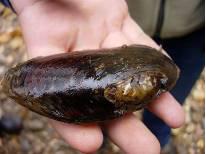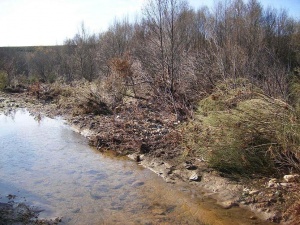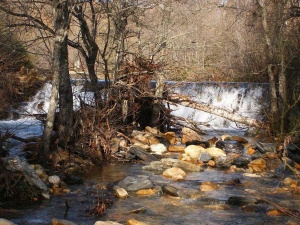Difference between revisions of "Negro"
(→Site description) |
(→References) |
||
| Line 73: | Line 73: | ||
==References== | ==References== | ||
<references/> | <references/> | ||
| + | http://www.ecrr.org/conf08/pdf/proceed5.pdf<br /> | ||
http://www.mma.es/secciones/acm/aguas_continent_zonas_asoc/dominio_hidraulico/conserv_restaur/pdf/Rio_Negro.pdf<br /> | http://www.mma.es/secciones/acm/aguas_continent_zonas_asoc/dominio_hidraulico/conserv_restaur/pdf/Rio_Negro.pdf<br /> | ||
Presentation of the project at the 4th ECRR International Conference on River Restoration | Presentation of the project at the 4th ECRR International Conference on River Restoration | ||
Revision as of 16:53, 14 April 2010
Negro
Key features of the case study
- The ecological improvement of the Negro river is part of a national river restoration programme, Estrategia Nacional de Restauración de Ríos, developed by the Ministerio de Ministerio de Medio Ambiente, y Medio Rural y Marino (Ministry of Environment). The Confederación Hidrográfica del Duero is the organism which has implemented this project, as others of the Duero basin.
- The principal objective of this initiative is to recover trout populations and the naiad Margaritifera margaritifera, which is in serious danger of extinction.
- The main threat to these species is the presence of weirs that make difficult or impossible the migration of the trouts upstream,which are the propagation vector of the naiads, affecting their reproduction.
Site description
The Negro river drains the the area located at the south of Sierra de la Cabrera, of siliceous substrate (gneiss, slate and quartzite). The climate is meaditerranean with atlantic influence. The vegetation at the basin is composed of Pinus sylvestris, Pinus nigra and Pinus pinaster, although the potential corresponds to Quercus pyrenaica, and
in the lower areas of the left bank, a dry series of Quercus rotundifolia. the intensive livestock farming, the use of fire and the deforestation of the basin led to the curent state of the vegetation.
The riparian vegetation in the middle and lower sections is dominated by a
siliciphilous riparian geomegaseries of Alnus glutinosa, while the upper
sections dominated by Salix salvifolia and other willows which, together
with the alders, jointly dominate some middle and lower sections. Important
riparian formation of Populus tremula on the lower section. State of
conservation: in the middle and lower areas these riparian strips coincide
with farmed alluvial plains, conserving narrow galleries which in some
places are highly degraded and in others have even disappeared (Rodriguez et al.,2008)[1].
The actiation area is located in protected areas: SCI ES4190067 "Riberas del río Tera", SCI ES4190110 "Sierra de la Cabrera" and ZEPA ES4130024 "Sierra de la Cabrera"
In hydrographic terms it belongs to the Duero basin, being a left-bank tributary of the river Tera, which in turn is a right-bank tributary of the Esla, subsequently flowing into the Duero via its right bankThe average flow is ususally less than 0.6 m/s, of clear waters as the suspended matter normally do not exceed 2 mg/l. However, forest fires and some management practices of the watershed, involve the sediment scouring, resulting in an increase of suspended solids and a noticeable loss of water quality.
The total or partial removal of riparian vegetation at some reaches has caused the loss of natural channel morphology. The transformation of the riparian forest and floodplain into flood meadows is another reason of morphological alteration.
There are various impoundments at the river for different uses(mills, forges, irrigation pipes,etc.)increasing the solids contribution and the interrupting the longitudinal connectivity.
Measures selection
The project aimed to:
- Recover aquatic populations and improve instream habitats
- Improve the composition and structure of the riparian vegetation
- Ameliorate longitudinal connectivity of the fluvial system
- Recover aquatic populations and improve instream habitats
The main measure is directed to improve the longitudinal continuity by the permeabilisation of 11 weirs, incorporating fish passing structures. The weir at the mouth of the Negro river is left impermeable in order to prevent the penetration of Lepomis gibosus from the Tera river. A complementary measure for the recovery of the target species is the installation of spawing structures for facilitate trout breeding.
Other measures can be summarized as follows:
- Silvicultural treatments, plantations and sowing for improve the riparian vegetation
- Buffer strips for reduce sediment input
- Channel morphology rehabilitation and sediment removal from the riverbed.
- Silvicultural treatments, plantations and sowing for improve the riparian vegetation
Success criteria
Ecological response
Hydromorphological response
Monitoring before and after implementation of the project
Socio-economic aspects
Extra background information
In the Douro basin, recent studies determined the presence of
several freshwater bivalve species, such as the naiad Margaritifera
margaritifera.
The interest of this species and the degree to which it is threatened
led to the development of a LIFE programme for its conservation in the Zamora SCI (LIFE03-NAT/E/000051)
promoted by the Regional Environment Department of the Regional
Government of Castile and Leon, and supported and cofinanced by the
Ministry of the Environment of the Government of Spain.
Work was carried out between the years 2003-2007 by specialised personnel who
assessed naiad populations (densities, composition and abundance) and
implemented actions for the conservation of this species. The Negro river´s naiad population, are the best conserved in the Duero basin, although it is found highly aged (60-80 years old) and fragmented.
The common trout, which is parasited by the larva phase of glochidia in a complex biological cycle.The naiad
larvae need to be attached to young strout guills for survival.
Contact person within the organization
References
- ↑ I. Rodríguez, Herrero J.M. & Gutiérrez F.Project for ecological improvement of river Negro and tributaries (Zamora-Spain) 4th ECRR Conference on River Restoration. Italy, Venice S. Servolo Island. 16-21 June 2008
http://www.ecrr.org/conf08/pdf/proceed5.pdf
http://www.mma.es/secciones/acm/aguas_continent_zonas_asoc/dominio_hidraulico/conserv_restaur/pdf/Rio_Negro.pdf
Presentation of the project at the 4th ECRR International Conference on River Restoration
[1]
Related Measures
- No measures have been assigned to this project.
Related Pressures
- No related pressures were found.


